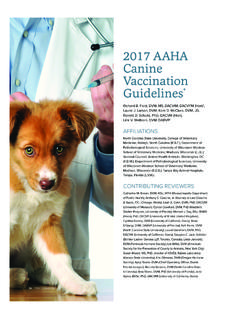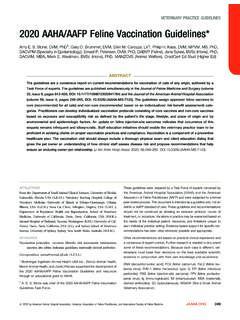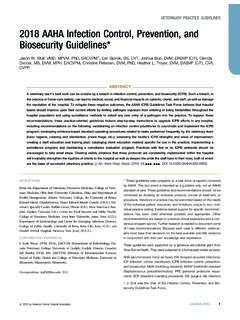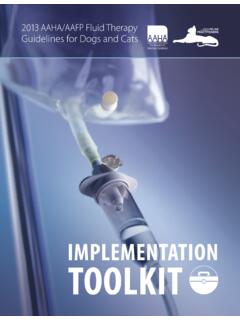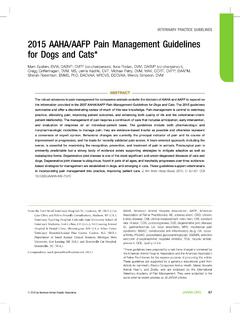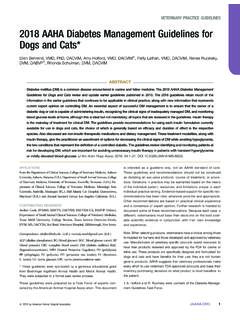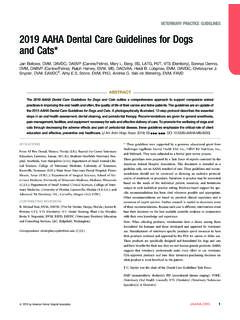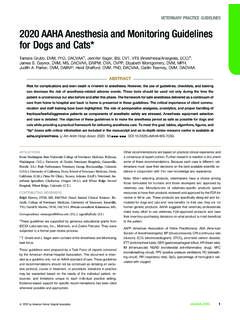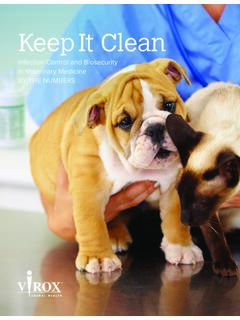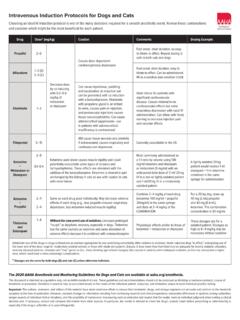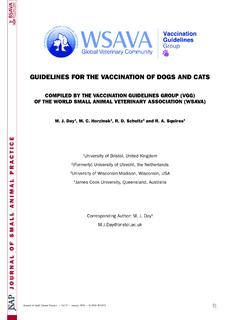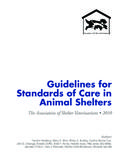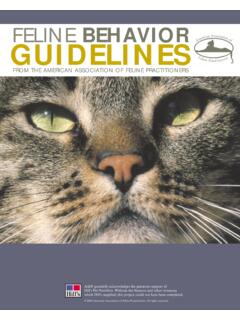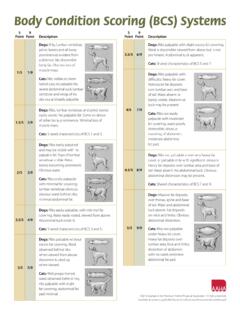Transcription of 2017 AAHA Canine Vaccination Guidelines
1 2017 AAHA. Canine Vaccination Guidelines *. Richard B. Ford, DVM, MS, DACVIM, DACVPM (Hon) , Laurie J. Larson, DVM, Kent D. McClure, DVM, JD, Ronald D. Schultz, PhD, DACVM (Hon), Link V. Welborn, DVM, DABVP . AFFILIATIONS. North Carolina State University, College of Veterinary Medicine, Raleigh, North Carolina ( ); Department of Pathobiological Sciences, University of Wisconsin-Madison School of Veterinary Medicine, Madison, Wisconsin ( );. General Counsel, animal Health Institute, Washington, DC. ( ); Department of Pathobiological Sciences, University of Wisconsin-Madison School of Veterinary Medicine, Madison, Wisconsin ( ); Tampa Bay animal Hospitals, Tampa, Florida ( ). CONTRIBUTING REVIEWERS. Catherine M. Brown, DVM, MSc, MPH (Massachusetts Department of Public Health); Anthony E. Cascino, Jr. Attorney at Law (Cascino & Assoc, ; Chicago, Illinois); Leah A. Cohn, DVM, PhD, DACVIM. (University of Missouri); Cynda Crawford, DVM, PhD (Maddie's Shelter Program, University of Florida); Michael J.
2 Day, BSc, BVMS. (Hons), PhD, DECVP (University of Bristol, United Kingdom);. Cynthia Delany, DVM (University of California, Davis); Brian DiGangi, DVM, DABVP (University of Florida); Kelli Ferris, DVM. (North Carolina State University); Laurel Gershwin, DVM, PhD, DACVM (University of California, Davis); Douglas C. Jack, Solicitor (Borden Ladner Gervais LLP, Toronto, Canada); Linda Janowitz, DVM (Peninsula Humane Society); Lila Miller, DVM ( american Society for the Prevention of Cruelty to Animals, New York City);. Susan Moore, MS, PhD, director of KSVDL Rabies Laboratory (Kansas State University); Kris Otteman, DVM (Oregon Humane Society); Apryl Steele, DVM (Chief Operating Officer, Dumb Friends League); Brenda Stevens, DVM (North Carolina State University); Amy Stone, DVM, PhD (University of Florida); Jane Sykes, BVSc, PhD, DACVIM (University of California, Davis). 26 TRENDS MAGAZINE. 26 9/12/17 10:46 AM. While there is often consensus on which Canine vaccines fall into core and noncore categories and when they should be administered, in practice, the Vaccination protocol should always be individualized based on the patient's risk factors, life stage, and lifestyle.
3 For this reason, these Guidelines are not intended to represent a universal Vaccination protocol applicable to all dogs. Instead, the Guidelines offer a range of recommendations that will aid practitioners in making rational decisions on vaccine selection for their individual patients. Executive Summary The AAHA Canine Vaccination Guidelines offer THE american animal hospital association important updates to previously published Guidelines as (AAHA) is pleased to introduce this revision of the Canine well as new, relevant information that directly impacts Vaccination Guidelines published, for the first time, the practicing veterinarian: as an online educational resource for the veterinary Updated, quick-reference tables summarizing medical profession. This format will allow for frequent Vaccination recommendations for client-owned and online updates as necessary. The revised AAHA Canine shelter-housed dogs. Vaccination Guidelines offer important updates to Internet links that provide ready access to regularly the 2011 Guidelines .
4 The content of the Guidelines updated online sources of information that will has been significantly expanded to facilitate efforts supplement the Guidelines themselves, for example, by practicing veterinarians to meet patient and client state-by-state information on rabies Vaccination law needs in a complex infectious disease environment. The and regulations, and comprehensive information on Guidelines are an authoritative source of evidence-based vaccine storage and handling. recommendations and expert opinion provided by Algorithms outlining indications for antibody the AAHA Canine Vaccination Guidelines Task Force. testing (serology) as well as recommended actions for The Task Force includes individuals with extensive patients with a positive or negative test result. experience in primary care practice, academia, shelter Product information on the emerging class medicine, public health, and veterinary law related to of immunotherapeutics approved for use in clinical practice.
5 Veterinary medicine. * These Guidelines were prepared by a task force of experts convened As one of the safest and most cost-effective means of by the american animal hospital association . This document is intended as a guideline only, not an AAHA standard of care. These Guidelines and infectious disease prevention, Vaccination has long been recommendations should not be construed as dictating an exclusive protocol, a focal point of Canine practice. This revision of the entire course of treatment, or procedure. Variations in practice may be warranted based on the needs of the individual patient, resources, and limitations AAHA Canine Vaccination Guidelines is presented in an unique to each individual practice setting. Evidence-based support for specific online format at recommendations has been cited whenever possible and appropriate. Other recommendations are based on practical clinical experience and a consensus Termed an Online Educational Resource, this iteration of expert opinion.
6 Further research is needed to document some of these of the AAHA Canine Vaccination Guidelines offers recommendations. Because each case is different, veterinarians must base their decisions on the best available scientific evidence in conjunction with readers immediate accessibility to current, must-know . their own knowledge and experience. information that directly impacts clinical practice on a These Guidelines were sponsored by a generous educational grant from daily basis. Boehringer Ingelheim, Merial, Merck animal Health, and Zoetis. They were subjected to a formal peer-review process. The AAHA Canine Vaccination Guidelines Task Force gratefully acknowledges the contribution of Mark The table on Vaccination recommendations in practice Dana of Scientific Communications Services, LLC, in the preparation of the is an up-to-date, master reference that functions as Executive Summary. a stand-alone resource covering all commercially Ford was the lead editor of the AAHA Canine Vaccination Guidelines available Canine vaccines licensed in the United States Task Force.
7 And Canada. Core and noncore vaccines are listed along Welborn was the chair of the AAHA Canine Vaccination Guidelines Task Force. October 2017 27. 27 9/12/17 10:46 AM. with recommendations for revaccination intervals and a selective approach to assessing an individual dog's various precautions. The table contains links to sections response to Vaccination . Determination of antibody in the Guidelines that provide additional, relevant detail. status is especially relevant for the assessment of patients This is the only section available in print in JAAHA. The that have an unknown Vaccination history, are overdue remainder of the sections listed below can be found at for Vaccination , those undergoing chemotherapy, those receiving immunosuppressive drugs, as well as patients with a history of vaccine adverse reactions. As noted in the section on legal considerations, The Guidelines include a new veterinarians can exercise some professional discretion section entitled therapeutic biologics in deviating from vaccine label recommendations, such as determining appropriate revaccination specifically directed at informing intervals based the patient's risk.
8 On the other hand, veterinarians about the availability and the protocol for administering rabies vaccinations intended use of these novel adjunctive is not discretionary. Decisions surrounding the administration of rabies vaccines require strict adherence immune-based therapies. to statutory requirements. The section on vaccine storage and handling summarizes Rabies vaccines are the only vaccines administered by must know information related to the storage and veterinarians that are required by law. Because rabies use of vaccines within the practice. Included are tips for laws may vary from state to state (or jurisdictions within avoiding misidentification of vaccines, monitoring storage states), a new section on rabies Vaccination provides conditions, and the consequences of subjecting vaccines to access to current state-by-state information on rabies out-of-range temperatures. A link to comprehensive Center and rabies Vaccination law, and regulations that directly for Disease Control (CDC) Guidelines for proper vaccine impact decisions veterinarians make in practice.
9 Storage and handling of vaccines is provided. Another new section offers recommendations for Immunotherapeutic products represent a rapidly dogs that are overdue for Vaccination . Vaccine-specific emerging class of biologics licensed for use in veterinary guidance is provided for what is often an ambiguous medicine. The Guidelines include a new section entitled aspect of veterinary practice, , the Canine patient that therapeutic biologics specifically directed at informing presents with an unknown or out-of-date Vaccination veterinarians about the availability and intended use of history. Recommendations for core and noncore vaccines these novel adjunctive immune-based therapies. are presented. In the section on frequently asked questions, readers will Shelter-housed dogs represent a sizeable population find informative recommendations for dealing with an of animals at increased risk of exposure to assortment of commonly encountered, vaccine-related vaccine-preventable infectious diseases.
10 The Guidelines situations seen in clinical practice. include an updated table on recommendations for Vaccination of shelter-housed dogs, including those in The AAHA Canine Vaccination Guidelines support the long-term housing facilities. implementation of effective, individualized pathways for the prevention of infectious diseases of dogs. Implicit Another novel component of the Guidelines is a in the Guidelines is the integral role Vaccination plays section on antibody testing (serology) as an adjunct to in the veterinary profession's emphasis on preventive Vaccination . Information is included that addresses healthcare and regular exams as the foundation of a long, not only the indications for testing, but also provides active, and rewarding relationship between pets and their recommended actions based on whether the test results human companions. To read these Guidelines in their are positive or negative. Antibody testing represents entirety, visit 28 TRENDS MAGAZINE.
